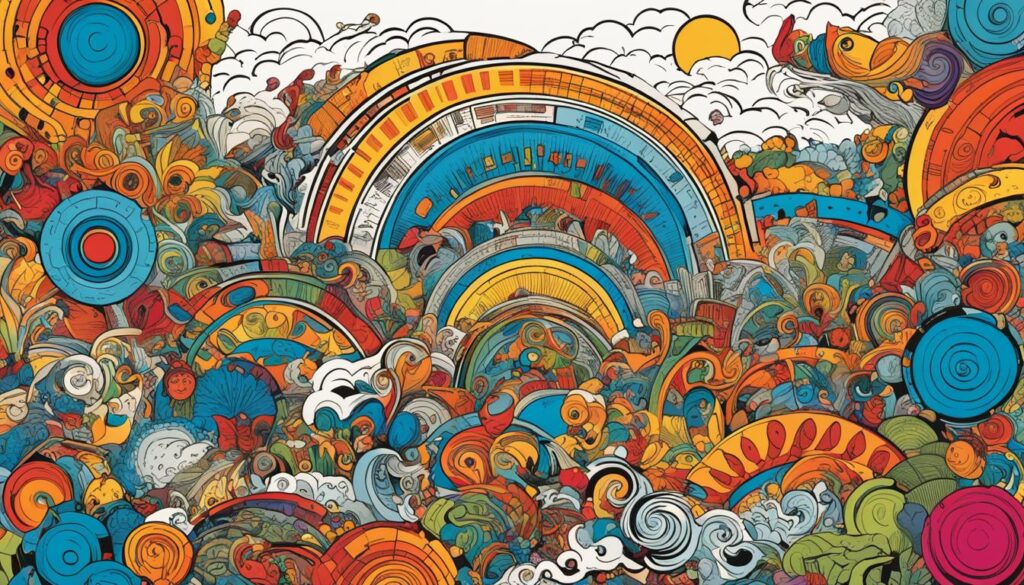Did you know that several languages spoken in Japan are on the verge of extinction? The Ryūkyūan Languages, also known as the Ryukyuan dialects or the Okinawan language, are a unique language family integral to Japan’s cultural heritage and identity. These languages are spoken in the Ryūkyū Islands, located in the southernmost part of the Japanese archipelago. However, despite their significance, UNESCO has classified four of the Ryūkyūan languages as “definitely endangered” and two others as “severely endangered.” The urgency to preserve these languages is no longer a choice but a necessity.
Within the scope of the Ryukyuan language family, the Amami language, Yaeyama language, and Miyako language exhibit unique linguistic features and cultural nuances. Each language represents a colorful thread that weaves together the rich tapestry of Japan’s linguistic diversity. Yet, these threads are slowly unraveling, and there is an urgent need to protect and revitalize these endangered languages.
Overview of Ryūkyūan Languages
The Ryūkyūan Languages are a fascinating language family with distinctive phonological and grammatical features that set them apart from other languages. Southern Ryukyuan languages, in particular, exhibit syllabic consonants and glottalized consonants, which are rare in most languages. Some Ryukyuan languages also have phonemic central vowels and voiceless nasal phonemes.
When it comes to sentence structure, the Ryūkyūan Languages follow an SOV (subject-object-verb) word order. They are dependent-marking, modifier-head, nominative-accusative languages. Adjectives in the Ryūkyūan Languages are typically bound morphemes, and these languages showcase contrastive pitch accent. Additionally, these languages employ topic and focus markers that can change form depending on the sentence context.
The linguistic features of the Ryūkyūan Languages highlight their unique character and cultural significance within the Ryukyuan language family.
The Phonological and Grammatical Features of Ryūkyūan Languages
Southern Ryukyuan languages stand out for their uncommon syllabic and glottalized consonants, which are not commonly found in other languages. This unique phonological characteristic distinguishes them from their linguistic counterparts in the Ryukyuan language family.
“The Ryūkyūan Languages are a linguistic treasure trove, showcasing diverse sounds and grammatical structures that provide insights into the cultural heritage of the Ryūkyū Islands.”
One notable grammatical feature of the Ryūkyūan Languages is their specific word order, which follows an SOV pattern. This means that the subject comes before the object, and both come before the verb. This structure differs from many other languages, contributing to the distinctiveness of the Ryūkyūan Languages.
Another linguistic characteristic of the Ryūkyūan Languages is the use of dependent marking and modifier-head constructions. In dependent marking, grammatical relationships are indicated through affixes or particles. Modifier-head constructions refer to the noun-modifier relationship in which the modifier follows the head noun.
Adjectives in the Ryūkyūan Languages are generally bound morphemes, meaning that they are affixed to other words instead of standing on their own as separate words. This feature adds complexity and richness to the language family.
Furthermore, the Ryūkyūan Languages exhibit a contrastive pitch accent, where the pitch pattern of a word can distinguish its meaning from other words with the same phonetic composition. This tonal system adds an additional dimension to the linguistic diversity of the Ryūkyūan Languages.
Overall, the Ryūkyūan Languages showcase a range of linguistic features that reflect the unique cultural heritage of the Ryūkyū Islands and contribute to the immense linguistic diversity of Japan.
Classification and Varieties of Ryūkyūan Languages
The Ryūkyūan Languages can be classified into two main groups: Northern Ryukyuan and Southern Ryukyuan. These groups encompass several distinct languages, each with its own unique characteristics:
Northern Ryukyuan:
- Amami language
- Kikai language
- Tokunoshima language
Southern Ryukyuan:
- Okinawan language
- Miyako language
- Yaeyama language
- Yonaguni language
While these languages share some similarities, they are not mutually intelligible. The Okinawan language, spoken in central and southern Okinawa Island, is the most widely known among the Ryūkyūan Languages.
| Language Group | Language | Speakers |
|---|---|---|
| Northern Ryukyuan | Amami language | Approximately 200,000 |
| Kikai language | Approximately 1,000 | |
| Tokunoshima language | Approximately 1,000 | |
| Southern Ryukyuan | Okinawan language | Approximately 1.3 million |
| Miyako language | Approximately 30,000 | |
| Yaeyama language | Approximately 50,000 | |
| Yonaguni language | Approximately 400 |
These Ryūkyūan Languages hold significant cultural and linguistic value and play an important role in preserving the rich heritage of the Ryukyu Islands.

Status and Endangerment of Ryūkyūan Languages
The Ryūkyūan Languages, such as the Okinawan language and the Amami language, are currently facing the threat of extinction. These unique languages, which are an essential part of Japan’s cultural heritage, are endangered due to various factors, including language shift and the influence of Japanese.
“The influence of Japanese and language shift towards the use of Standard Japanese and dialects like Okinawan Japanese have resulted in a decline in the number of speakers of these languages.”
Language shift refers to the gradual adoption of a dominant language by a community, resulting in the decline or loss of minority languages. In the case of the Ryūkyūan Languages, the widespread usage of Standard Japanese and Okinawan Japanese dialects has contributed to the decrease in the number of fluent speakers.
According to UNESCO, four Ryūkyūan languages are classified as “definitely endangered,” indicating a high risk of the language no longer being spoken as the first language in the near future. Additionally, two Ryūkyūan languages are considered “severely endangered,” further highlighting the urgent need for preservation efforts.
It is worth noting that the majority of fluent speakers of the Ryūkyūan Languages are from the older generation. The younger generations, influenced by societal and educational factors, tend to prefer using Standard Japanese in their everyday lives.
Unfortunately, the current language policy in Japan provides limited opportunities for language revitalization and preservation of the Ryūkyūan Languages. However, there are grassroots efforts underway to preserve and revitalize these endangered languages.
“Grassroots efforts, such as cultural activities and media programs, play a crucial role in preserving and revitalizing the Ryūkyūan Languages.”
Various cultural activities, language classes, and media programs are being organized to raise awareness about the importance of the Ryūkyūan Languages and encourage their use among the community. These initiatives aim to instill a sense of pride and identity in the younger generations and promote the continued use of these languages.
To ensure the survival of the Ryūkyūan Languages, it is essential for the government and relevant organizations to support language revitalization efforts and create policies that promote the use of these endangered languages in various domains, such as education and media.
Classification of Ryūkyūan Languages
| Ryūkyūan Language | Classification |
|---|---|
| Okinawan language | Southern Ryukyuan language |
| Amami language | Northern Ryukyuan language |
| Miyako language | Southern Ryukyuan language |
| Yaeyama language | Southern Ryukyuan language |
| Yonaguni language | Southern Ryukyuan language |
The table above provides an overview of the classification of Ryūkyūan Languages. It illustrates the categorization of each language into either the Southern Ryukyuan or Northern Ryukyuan subgroup. Each language within these subgroups has its own unique characteristics and distinct linguistic features.
Despite the challenges and endangerment, it is crucial to recognize the value and significance of the Ryūkyūan Languages. Preserving and revitalizing these languages not only ensures the diversity of Japan’s linguistic heritage but also reinforces the cultural identity of the Ryūkyū Islands.
History and Language Evolution of Ryūkyūan Languages
The Ryūkyūan Languages have a rich history that traces back to the first millennium when the Ryukyu Islands were inhabited by Proto-Japonic speakers. These languages evolved over time, diverging from the varieties of Proto-Japonic spoken in mainland Japan, which later developed into Old Japanese. The linguistic changes in the Ryūkyūan Languages differ from those in Japanese, resulting in significant differences between the two language groups.
Unfortunately, the exact origins of the Ryūkyūan Languages and their relationship to other languages are still subjects of ongoing research and debate among linguists. However, it is widely acknowledged that the Ryūkyūan Languages have their own unique characteristics and form a distinct language family within the Japonic language family.
The Future of Ryūkyūan Languages
The future of the Ryūkyūan Languages relies on the collaborative efforts of individuals, organizations, and the government to ensure their preservation and promotion. Despite the challenges and the endangerment of these languages, there is a positive language attitude among the population, with a significant percentage showing support for the inclusion of Ryūkyūan languages in the education system.
Grassroots efforts are playing a crucial role in maintaining and revitalizing the Ryūkyūan Languages. Cultural activities that celebrate the linguistic heritage and traditions associated with these languages help foster a sense of pride and identity within the community. Additionally, the use of social media platforms enables the wider dissemination of Ryūkyūan language resources and educational content, reaching a broader audience.
However, to secure the future of the Ryūkyūan Languages, there is an urgent need for a comprehensive language policy that supports their preservation and promotion. This policy should encompass language revitalization programs, official recognition and support for Ryūkyūan language learning, and the integration of the languages into various aspects of society, including education, media, and public discourse. By doing so, the Ryūkyūan Languages can continue to thrive and be an integral part of Japan’s cultural heritage and identity for generations to come.
FAQ
What are the Ryūkyūan Languages?
The Ryūkyūan Languages, also known as the Ryukyuan dialects or Okinawan language, are a unique language family spoken in the Ryūkyū Islands, the southernmost part of the Japanese archipelago. They belong to the Japonic language family but are separate languages from Japanese.
How are the Ryūkyūan Languages classified?
The Ryūkyūan Languages can be classified into two main groups: Northern Ryukyuan and Southern Ryukyuan. The Northern Ryukyuan subgroup includes languages such as Amami, Kikai, and Tokunoshima. The Southern Ryukyuan subgroup includes languages like Okinawan, Miyako, Yaeyama, and Yonaguni.
What is the current status of the Ryūkyūan Languages?
The Ryūkyūan Languages are endangered, with four languages classified as “definitely endangered” and two others as “severely endangered” by UNESCO. There has been a decline in the number of speakers due to the influence of Japanese and language shift towards the use of Standard Japanese and Okinawan Japanese dialects.
What are some unique features of the Ryūkyūan Languages?
The Ryūkyūan Languages have phonological and grammatical features that distinguish them from other languages. They have syllabic and glottalized consonants, phonemic central vowels, and voiceless nasal phonemes. The languages follow an SOV word order, are dependent-marking, modifier-head, nominative-accusative languages, and exhibit contrastive pitch accent.
What is the history of the Ryūkyūan Languages?
The Ryūkyūan Languages have a rich history that dates back to the first millennium when the Ryukyu Islands were populated by Proto-Japonic speakers. Over time, the languages diverged from the varieties of Proto-Japonic spoken in mainland Japan, resulting in significant linguistic differences between the two language groups.
What is being done to preserve the Ryūkyūan Languages?
Despite the challenges and language endangerment, there are grassroots efforts, cultural activities, and media programs aimed at preserving and revitalizing the Ryūkyūan Languages. However, there is a pressing need for a language policy that supports their preservation and promotion as an integral part of Japan’s cultural heritage and identity.
